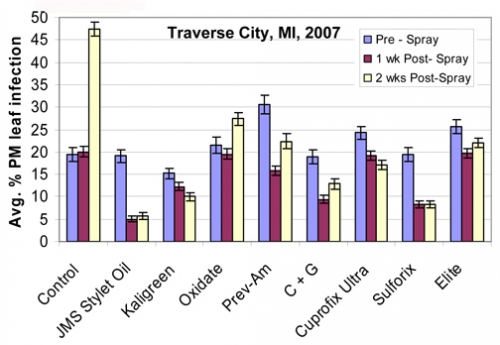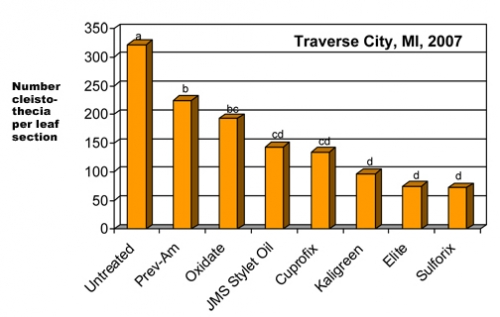Late-season control of powdery mildew in grapes: Eradicative treatments
Editor’s note: This article is from the archives of the MSU Crop Advisory Team Alerts. Check the label of any pesticide referenced to ensure your use is included.
The general approach to powdery mildew management is to apply preventative fungicide sprays and canopy management. But sometimes a situation can get out of control even in the best vineyards, particularly if rain and wind have prevented application of fungicides at critical times. Powdery mildew is a disease that is difficult to control once it gets a foothold. While we have many effective fungicides for preventative and curative control of powdery mildew in grapes, (e.g., Nova, Elite, Flint, Abound, Sovran, Pristine, Quintec, Endura, etc.), not many fungicides can eradicate existing colonies. In fact, spraying systemic fungicides on raging infections is not very effective and can encourage fungicide resistance development. At most, you can expect to suppress sporulation while you keep infections from spreading to healthy clusters and leaves. Small plot efficacy trials in grapes have shown that Stylet Oil, Sulforix, and Kaligreen have good eradicative properties and can reduce the number of visible colonies (see graphs). To reduce the number of cleistothecia (overwintering structures), Sulforix, Elite, and Kaligreen appeared most effective. Do not apply Sulforix to sulfur-sensitive varieties. More than two applications of Stylet Oil may suppress brix accumulation.
A few things to remember when applying eradicative sprays:
- Apply treatments as soon as possible after symptoms are seen (regular and careful scouting is important).
- Waiting a little longer to ensure good spray conditions is better than spraying immediately under poor spray conditions.
- Remove infected clusters (if possible) and leaf pull to ensure good spray coverage of fruit zone and reduce humidity around clusters.
- Ensure thorough coverage of leaves and bunches, which means increasing spray volume (50-100 gal/acre) and spraying every row.
- Ensure forward protection of healthy plant parts by tank-mixing or applying materials that have good protective activity.
- Always read the label for the pre-harvest interval, incompatibility with other products, and other restrictions.
- Scout again to see if your treatment was effective. Also check for possible phytotoxicity.



 Print
Print Email
Email






